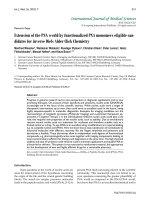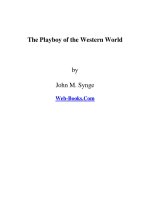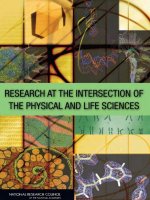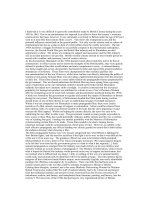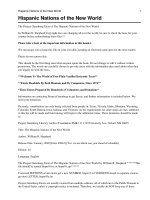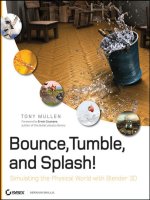MAX human centric searching of the physical world
Bạn đang xem bản rút gọn của tài liệu. Xem và tải ngay bản đầy đủ của tài liệu tại đây (800.21 KB, 95 trang )
MAX
HUMAN-CENTRIC SEARCHING OF THE PHYSICAL WORLD
YAP KOK KIONG
NATIONAL UNIVERSITY OF SINGAPORE
2006
MAX
HUMAN-CENTRIC SEARCHING OF THE PHYSICAL WORLD
YAP KOK KIONG
(B.Eng. (Hons), NUS )
A THESIS SUBMITTED
FOR THE DEGREE OF MASTER OF ENGINEERING
DEPARTMENT OF ELECTRICAL & COMPUTER ENGINEERING
NATIONAL UNIVERSITY OF SINGAPORE
2006
Name
:
Yap Kok Kiong
Degree
:
Master of Engineering
Supervisor(s)
:
Mehul Motani and Vikram Srinivasan
Department
:
Department of Electrical & Computer Engineering
Thesis Title
:
MAX
Human-Centric Searching of the Physical World
Abstract
is a vision of searching the physical world in seconds,
as we are searching the Internet today. Built on the intuition that humans
are powerful “sensors” that works well with landmark based information,
we design the system to allow people to search for and locate objects as
and when they need it, instead of organizing them a priori. Location information are presented in a form natural to humans in the system, i.e., with
reference to identifiable landmarks (e.g., on the dining table) rather than
precise coordinates.
MAX was designed with three main objectives in mind: (i) humancentric operation, (ii) privacy, and (iii) efficient search of any tagged object.
In the system, all physical objects, from documents to clothing, can be
tagged and people locate objects using an intuitive search interface.
In this thesis, we propose a hierarchical architecture consisting of tags
(bound to objects), sub-stations (bound to landmarks) and base-stations
(bound to localities), to facilitate an efficient search. To optimize system
performance, we present a methodology to design energy and delay optimal
query protocols for a variety of device choices. Also we provide privacy for
the users of MAX. Tags can be marked as either public or private, with
private tags searchable only by the owner. MAX also provides for privacy of
physical spaces. MAX requires minimal initial configuration, and is robust
to reconfiguration of the physical space.
i
We also present an implementation of MAX, providing search facility
for the wide physical area. We contend that a MAX-like search system will
enable sharing (e.g., books on a college campus) and trading (e.g., buying
and selling used books) of physical resources, and will be the engine for a
host of new applications. It is our thesis that the ability to efficiently search
the physical world through MAX will provide unprecedented convenience to
people.
Keywords
:
MAX, human-centric, sensor networks, search, optimal protocols
ii
Acknowledgment
I would like to express gratitude for my supervisors, Dr. Mehul Motani
and Dr. Vikram Srinivasan for their guidance, advices and support through
these years. The opportunities and recognition given by them has also been
an important motivation for me during the course of research. This thesis
would not be possible without their ideas and contributions.
I would also like to express my appreciation for the work done by Huang
Limei, Philip Lim Chern Sia and Tran Trong Tri. Their hard work in developing the prototypes provided much experience for the development of
MAX-Sesshoumaru. I would also like to thank Yu Sern Hong for his artwork
being used as the logo for MAX-Sesshoumaru.
Special thanks goes to Dr. Tham Chen Khong, Yeow Wai Leong, Rob
Hoes, Hoang Anh Tuan, Vineet Srivastava, Lawrence Ong Lee Chong, Chong
Hon Fah, Wang Wei, Lim Yang Cherng and William Low for everything they
have done for me and my work.
What I have done during the pursuit of this degree would not be possible
with the concern and support given to me by my wife, Wang Huiyi Serene.
For this, I cannot say enough thanks.
I would also like to acknowledge the sponsorship from National University of Singapore under the Research Scholarship scheme. Last but not least,
I would like to thank anyone I have failed to mention here, that have made
this work possible.
December 6, 2006
iii
Contents
1 Introduction
1
1.1
Searching the Physical World . . . . . . . . . . . . . . . . . .
2
1.2
Contributions . . . . . . . . . . . . . . . . . . . . . . . . . . .
4
1.3
Organization of Thesis . . . . . . . . . . . . . . . . . . . . . .
5
2 Literature Survey
2.1
6
Location Tracking Technologies . . . . . . . . . . . . . . . . .
6
2.1.1
Localization . . . . . . . . . . . . . . . . . . . . . . . .
6
2.1.2
Urban Location Tracking . . . . . . . . . . . . . . . .
7
2.1.3
Radio Frequencies Identification Device Systems . . .
8
Smart Spaces . . . . . . . . . . . . . . . . . . . . . . . . . . .
8
2.2.1
Location Support System . . . . . . . . . . . . . . . .
8
2.3
Location Aware Computing . . . . . . . . . . . . . . . . . . .
9
2.4
Sensor Database . . . . . . . . . . . . . . . . . . . . . . . . .
9
2.2
3 Architecture and Design
3.1
3.2
3.3
11
System Architecture in a Locality . . . . . . . . . . . . . . . .
11
3.1.1
Entities of the Architecture . . . . . . . . . . . . . . .
12
Network Wide Architecture . . . . . . . . . . . . . . . . . . .
15
3.2.1
Functions of Various Entities . . . . . . . . . . . . . .
17
System Operation . . . . . . . . . . . . . . . . . . . . . . . .
18
4 Optimal Query Protocols
4.1
4.2
20
Methodology . . . . . . . . . . . . . . . . . . . . . . . . . . .
20
4.1.1
System Model . . . . . . . . . . . . . . . . . . . . . . .
20
4.1.2
Illustration of System Model . . . . . . . . . . . . . .
22
Optimal Protocols . . . . . . . . . . . . . . . . . . . . . . . .
23
4.2.1
25
Parameters of Optimization . . . . . . . . . . . . . . .
iv
4.2.2
4.3
Results of Optimization . . . . . . . . . . . . . . . . .
25
Design Choices . . . . . . . . . . . . . . . . . . . . . . . . . .
28
4.3.1
Customized versus Commercial Off-The-Shelf Tags . .
30
4.3.2
Distribution of Computational Burden . . . . . . . . .
33
4.3.3
Maximally Relevant Result . . . . . . . . . . . . . . .
35
4.3.4
Coverage – Degree of Overlap . . . . . . . . . . . . . .
36
4.3.5
Scalability – Number of Tags . . . . . . . . . . . . . .
37
5 Object and Space Privacy
5.1
5.2
5.3
39
Object Privacy . . . . . . . . . . . . . . . . . . . . . . . . . .
40
5.1.1
Cryptography for Object Privacy . . . . . . . . . . . .
40
5.1.2
Elliptic Curve Cryptography . . . . . . . . . . . . . .
41
Space Privacy . . . . . . . . . . . . . . . . . . . . . . . . . . .
41
5.2.1
Notion of Private Spaces . . . . . . . . . . . . . . . . .
42
5.2.2
Mechanism for Space Privacy . . . . . . . . . . . . . .
43
5.2.3
Privacy over the Wireless Channel . . . . . . . . . . .
44
Summary of Privacy . . . . . . . . . . . . . . . . . . . . . . .
44
6 Implementation – Sesshoumaru
6.1
47
MAX in a Locality . . . . . . . . . . . . . . . . . . . . . . . .
48
6.1.1
Tags . . . . . . . . . . . . . . . . . . . . . . . . . . . .
48
6.1.2
Sub-Station . . . . . . . . . . . . . . . . . . . . . . . .
49
6.1.3
Communication . . . . . . . . . . . . . . . . . . . . . .
51
6.2
Wide Area Search . . . . . . . . . . . . . . . . . . . . . . . .
51
6.3
Privacy . . . . . . . . . . . . . . . . . . . . . . . . . . . . . .
53
6.3.1
Secure Sockets Layer in Java . . . . . . . . . . . . . .
53
6.3.2
Elliptic Curve Cryptography in Java . . . . . . . . . .
54
What We Have Done . . . . . . . . . . . . . . . . . . . . . . .
54
6.4
7 Reflections, Future Work and Conclusion
7.1
56
Reflections . . . . . . . . . . . . . . . . . . . . . . . . . . . . .
56
7.1.1
RSSI is a Good Indicator of Proximity . . . . . . . . .
56
7.1.2
Landmark Based Localization is Enough . . . . . . . .
57
7.1.3
Importance of Reliable Communication . . . . . . . .
57
7.1.4
Privacy is an Intrinsic Part of a System . . . . . . . .
58
7.2
Future Work . . . . . . . . . . . . . . . . . . . . . . . . . . .
58
7.3
Conclusion . . . . . . . . . . . . . . . . . . . . . . . . . . . .
59
v
A List of Publications
64
B List of Optimal Protocols
65
C MAXSesshourmaru – TinyOS Components
70
C.1 Tags . . . . . . . . . . . . . . . . . . . . . . . . . . . . . . . .
70
C.1.1 ReliableComm . . . . . . . . . . . . . . . . . . . . . .
70
C.1.2 SingleDescriptor . . . . . . . . . . . . . . . . . . . . .
72
C.1.3 Query . . . . . . . . . . . . . . . . . . . . . . . . . . .
72
C.2 Sub-Station . . . . . . . . . . . . . . . . . . . . . . . . . . . .
73
C.2.1 Inventory . . . . . . . . . . . . . . . . . . . . . . . . .
73
C.2.2 Descriptor . . . . . . . . . . . . . . . . . . . . . . . . .
74
C.3 Administrative Components . . . . . . . . . . . . . . . . . . .
74
C.3.1 Radio433 . . . . . . . . . . . . . . . . . . . . . . . . .
74
C.3.2 ObjectId
. . . . . . . . . . . . . . . . . . . . . . . . .
75
C.3.3 NoQuery and NoDescriptorM . . . . . . . . . . . . . .
75
D MAXSesshourmaru – Java Components
76
D.1 MAX Server . . . . . . . . . . . . . . . . . . . . . . . . . . . .
76
D.2 Base Station
. . . . . . . . . . . . . . . . . . . . . . . . . . .
77
D.3 Query Terminal . . . . . . . . . . . . . . . . . . . . . . . . . .
77
D.4 Miscellaneous Components
79
. . . . . . . . . . . . . . . . . . .
vi
List of Figures
3.1
Three-tiered Architecture of MAX in a Locality – The Base
Station (BS) of the locality is connected to the various SubStation (SS), which in turns communicate with the tags to
provide an efficient search within the locality. . . . . . . . . .
3.2
13
Architecture of MAX over the Backbone Network – An user
in the system is co-located with the Query Terminal (QT).
The QT communicates with the MAX Server (MS), and subsequently the localities. The architecture at each locality is
outlined. For details, one can refer to Fig. 3.1. One should
note the background communication between the MS and localities. . . . . . . . . . . . . . . . . . . . . . . . . . . . . . .
3.3
16
Screen Shot of a Browser accessing MAX-Sesshoumaru Search
Engine . . . . . . . . . . . . . . . . . . . . . . . . . . . . . . .
18
4.1
State and Graph Forming Algorithm . . . . . . . . . . . . . .
24
4.2
Graph yield for sample problem using algorithm described
– The costless action a0 is shown in gray, while the other
actions are described in Table 4.2. The primitive states are
separately described in Table 4.1. . . . . . . . . . . . . . . . .
4.3
24
Smart Tags to Dumb Tags – Both energy consumption and latency increases when the tags are disallowed from calculating
and transmitting their match count. . . . . . . . . . . . . . .
4.4
32
Centralized Decision to Distributed Decision – When the SS
in a high overlap system are disallowed from deciding which
results are to be returned, the energy consumed decreases
slightly while the delay is decreased significantly. . . . . . . .
vii
34
4.5
Heuristic Result to Maximally Relevant Result – To ensure
maximally relevant results, the energy consumed increases
slightly but the latency increases drastically. . . . . . . . . . .
4.6
35
Increasing Degree of Overlap – Both energy consumption and
latency increases with increased overlap, especially significant
in systems using dumb tags. . . . . . . . . . . . . . . . . . . .
36
4.7
Scalability – Effects of increasing number of tags. . . . . . . .
38
5.1
Security Features within the MAX Architecture – An user
in the system is co-located with the Query Terminal (QT),
thus it is the “digital user” that communicates with the MAX
Server (MS) and Base Station (BS) to perform a query. . . .
6.1
45
Connection Diagram for Tag – Connection diagrams for the
sub-components can be found in Appendix C Section C.1 and
Section C.3. . . . . . . . . . . . . . . . . . . . . . . . . . . . .
6.2
49
Connection Diagram for Sub-Station – Connection diagrams
for the sub-components can be found in Appendix C Section C.2 and Section C.3. . . . . . . . . . . . . . . . . . . . .
6.3
50
Structure TinyOS Packet used – where the size of each part
(in bytes) is indicated below the message.
Length refers
to length of the payload. WORD LENGTH and INVENTORY SIZE are constants defined in the applications, taking
default values of 26 and 10 respectively. Details can be found
in [1]. . . . . . . . . . . . . . . . . . . . . . . . . . . . . . . .
52
6.4
Interactions between entities in a Wide Area Search . . . . .
52
6.5
Background Processes Running for MAX – (i) MAX Server
running and processing requests; (ii) SerialForwarder to access TOSBase; and (iii) the Base Station processing a user query. 55
C.1 Connection Diagram for ReliableComm . . . . . . . . . . . .
71
C.2 Connection Diagram for SingleDescriptor . . . . . . . . . . .
72
C.3 Connection Diagram for Query . . . . . . . . . . . . . . . . .
73
C.4 Connection Diagram for Inventory . . . . . . . . . . . . . . .
73
C.5 Connection Diagram for Descriptor . . . . . . . . . . . . . . .
74
C.6 Connection Diagram for Radio433 . . . . . . . . . . . . . . .
74
D.1 Java Components used in MAX Server . . . . . . . . . . . . .
77
viii
D.2 Java Components used in Base Station . . . . . . . . . . . . .
78
D.3 Java Components used in Query Terminal . . . . . . . . . . .
78
ix
List of Tables
4.1
List of Primitive States . . . . . . . . . . . . . . . . . . . . .
23
4.2
List of Actions . . . . . . . . . . . . . . . . . . . . . . . . . .
23
4.3
Hardware Device Parameters . . . . . . . . . . . . . . . . . .
26
4.4
Optimization Parameters . . . . . . . . . . . . . . . . . . . .
27
4.5
Optimal Protocols for Various Circumstances . . . . . . . . .
28
4.6
Optimal Protocols for Different Tag Density . . . . . . . . . .
29
5.1
Results returned for Each User during Search in Alice’s Pri-
6.1
vate Space . . . . . . . . . . . . . . . . . . . . . . . . . . . . .
43
Memory Consumption (in bytes) of Tag and Sub-Station. . .
48
x
List of Symbols
A
set of all actions
As
set of all actions valid for state s
a
action, refer to Definition 3
C(p)
cost of protocol, refer to Definition 4
c(a)
cost of action, refer to Definition 3
G
graph
OS
LTack
OS
LTmax
length of acknowledgment packet in prototype
LM
length of match value
LR
length of RSSI values
LQ
length of query
LD
maximum length of descriptor
LW
length of each word
m
length of plaintext
NS
number of SS
NT
number of tags
PSA
PST
T OS
Pack
power required by SS to be awake/processing
maximum length of a packet in prototype
power required by SS to transmit to BS
transmission duration of acknowledgment packet in pro-
T OS
Pmax
totype
maximum transmission duration of packet in prototype
PT
power required by SS to transmit tags
PV (sS , sE )
set of valid protocols
p
protocol, refer to Definition 4
p∗ (sS , sE )
RT OS
optimal protocol, refer to (4.4) and (4.3)
RS
data rate of communication between BS and SS
RT
data rate of communication between SS and tags
speed of communication in prototype
xi
S
set of all states
SS
processing speed of SS
ST
processing speed of tags
sP
primitive state, refer to Definition 1
s
state of system, refer to Definition 2
sS
starting state
sE
desired end state
ς P (a)
primitive pre-requisite state for action a
ς(a)
set of state that contains primitive pre-requisite state for
ζ P (a)
action a
primitive state that action a brings about
xii
List of Abbreviations
A-GPS Assisted GPS
AM Active Message
AP Access Point
ARQ Automatic Repeat reQuest
ATM Automatic Teller Machine
BS Base Station
CBC Cipher Block Chaining
COTS Commercial Off-The-Shelf
ECC Elliptic Curve Cryptography
EEPROM Electrically Erasable Programmable Read-Only-Memory
E-OTD Enhanced Observed Time Difference
GPS Global Positioning System
HMI Human Machine Interface
JECC Elliptic Curve Cryptography in Java
JSSE Java Secure Socket Extension
LAC Location Aware Computing
LAN Local Area Network
ORL Olivetti and Oracle Research Laboratory
xiii
MD5 RSA Data Security MD5 Message-Digest Algorithm
MS MAX Server
QT Query Terminal
RAM Read Access Memory
ROM Read Only Memory
RFID Radio Frequencies Identification Device
RSSI Received Signal Strength Indicator
SS Sub-Station
SSL Secure Sockets Layer
TOS TinyOS
UL-TOA Up-Link Time of Arrival
UWB ultra-wideband
WSN Wireless Sensor Networks
WWAN Wireless Wide Area Network
xiv
Chapter 1
Introduction
It is evident in history that an important objective of technology is to make
people’s lives better. This is especially clear in the course of the last few
decades, where it is inarguable that our lives are revolutionized by information and communication technology. This can be easily seen in the following
examples, which are close to heart for most.
• The Internet has allowed information to be readily available, allowing
for many convenience previously not possible. For example, now a
person can purchase everything from grocery to electronics right from
her own home, through e-commerce over the Internet.
• Wireless technology, such as cellular networks, allows people to meet
up spontaneously. One can now always call her friend for an ad hoc
meeting anywhere convenient. In fact, it is not even necessary to agree
on a precise location a priori. One will simply call the other party a
call upon reaching the area.
• Credit cards and Automatic Teller Machine (ATM) have eliminated
the need to carry sufficient cash before visiting a restaurant or even
another country. The correct currency and amount is also readily
available around the next corner.
• Search engines, such as GoogleTM , are so efficient that it is not necessary to download and archive data locally. This is because the information can always be relocated with the same set of keywords.
1
Another possible perspective of these technologies is that they have allowed for people to be more “disorganized”, without compromising efficiency.
This means less time and effort in planning and organization. For example,
GoogleTM has made archiving and organizing data unnecessary. This view
is of particular interest here.
1.1
Searching the Physical World
It is the thesis of this dissertation that the ability to efficiently search the
physical world will allow greater convenience to the current society. This
will allow humans to be more “disorganized” with their belongings without
any loss of efficiency in finding them. Hence we propose MAX1 , a system
that allows information of a “chaotic” space to be readily gathered, ordered
and presented to the user.
We contend that such a system has far reaching implications and applications, that will change the way we live today. With MAX, we will shift
from a paradigm of “everything has its place” to a paradigm of “everything
has a place”. Today, we assign a space for all our belongings. This is the
case for people in their daily living, and even more true for organizations in
their offices and warehouses. The MAX system will allow these assignments
of space to be redundant. In other words, you can put your belongings
anywhere in your room and find it when you need to.
One may question if such a system is even possible. At this juncture
of time, technology has matured for such a system to be available in the
foreseeable future, not so far from now. Current trends of technology, such
as smart paints, smart dust, Radio Frequencies Identification Device (RFID)
tags and smart spaces, points to a future where the environment can be
embedded with many electronic devices. These small devices, with limited
processing and communication capabilities, can be tagged on almost all, if
not all, physical objects. This is the pre-requisite we need for MAX, an
information and communication system to search a physical space quickly
and efficiently.
Before delving into the detailed system architecture and design for the
rest of the thesis, we will enumerate the design goals of the system here.
1
MAX is short for Maxwell’s Demon, which was proposed by mathematician James
Clerk Maxwell. The imaginary creature is thought of to create order from disorder, allegedly violating the second law of thermodynamics.
2
Human-centric Operation For MAX to be of use to the general public,
the system must be simple to install and easy to use. Central to
this theme of user-friendliness, the use of natural human language
is essential to allow the ease of interaction with the system. Natural
human language will thus be accepted as input and provided as output.
A subtle requirement would be for the system to be robust to reconfiguration of physical space. By this, we mean that no or minimal action
will be required when such reconfigurations occur. For example, one
will not want to spend an hour to recalibrate the system after moving
her table to the other side of the room.
Security and Privacy By security, we mean that system is protected from
unauthorized access. This will consist of two considerations as follows.
• The movement and location of private objects, such as one’s passport, should not be readily available to anyone. These objects
should not be continuously monitored and tracked too. We term
this as object privacy.
• The system should also provide various degrees of accessibility for
physical spaces, such as a room or an office. This is necessary to
prevent unauthorized access into personal spaces, such as one’s
bedroom. One may view this as preventing “digital trespassing”,
which we call space privacy.
Efficient Search for a Scalable Long-lived System Finally, there is a
certain economy of scale in MAX, though the system can be useful even
at a personal level. Thus, the system has to be provisioned for millions
or even trillions of objects to be searched across large distances and
over considerable areas. The resulting implication is that an efficient
searching mechanism would be required, for the results to be delivered
under reasonable latency.
At the same time, to minimize the chore of maintenance, the system
should be long-lived. Batteries should not be changed every week.
Thus, energy efficiency of the design is important. We also have to
consider the resource constraints of the wireless devices, that have
limited processing and communication capabilities.
3
For MAX to provide efficient service and to satisfy the design goals
outlined, we put forth the observation that humans are powerful “sensors”.
Thus, humans only require approximate coordinates in the form of cues and
landmarks to locate objects quickly. As a matter of fact, humans are not
proficient in using absolute coordinates to locate objects. This observation
will greatly simplify the design of MAX and allows for the design goals to
be fulfilled.
The search capability and provision of privacy in the system mimics the
information sharing within the digital world. We contend that this will
enable a plethora of applications far beyond what we can imagine, let only
list exhaustively. As an illustration, MAX would empower the sharing of
books and papers in a campus environment. Expensive books or difficultto-find papers can be easily located via the system and thus shared among
faculty and students. This opens up an enormous library of resources to
the entire community. Given such ease of sharing, one can easily foresee the
simplicity of trading these items.
1.2
Contributions
Other than the vision of MAX and our simple but yet powerful observation
that humans are powerful “sensors”, the specific contributions of this thesis
are listed in the following.
1. We design and propose an architecture for MAX. The wide area architecture exploits the ubiquitous Internet to provide search capabilities
across large distances. For each locality, a three-tiered hierarchical architecture, consisting of Base Station (BS), Sub-Station (SS) and tags,
is proposed. This “bridge” between the physical world and the digital
domain allows for efficiency, while maintaining simplicity.
2. We also investigate the privacy requirements of MAX as an application. From the investigation, we distill the notions of space and object
privacy. We then provision both forms of privacy in our system, including the new notion of privacy of physical spaces.
3. A methodology for designing energy and delay optimal query protocols
is developed. Using this methodology, the optimal protocols for various
4
system and device choices are derived. From these derived protocols,
we distill insights into the proper design of MAX.
4. Finally, we implement a prototype using Crossbow MICA motes [2],
building on our results and previous prototype experiences. Other
than providing strong evidence on MAX’s practicality and user trials, the implementation gives us experience that will be invaluable to
future MAX systems.
1.3
Organization of Thesis
We begin the thesis with a survey of recent related work in the next chapter.
We proceed to describe the system architecture and design in Chapter 3. The
methodology for deriving the optimal protocols and its resulting protocols
are then discussed in Chapter 4. The privacy requirements of the system
and the mechanism to achieve it is subsequently described in Chapter 5.
Finally, we provide the description of an implementation in Chapter 6, before concluding this thesis together with a discussion on the possible future
developments.
5
Chapter 2
Literature Survey
While this application is uniquely different from the rest of the proposals
that we know of, it is related to other fields of researches, such as location
tracking systems and smart environments which may require location support. Moreover, MAX exploits current technologies, such as developments
in RFID and Location Aware Computing (LAC). Thus, we present a survey
of these work.
2.1
Location Tracking Technologies
Location tracking technologies are developed to proactively monitor the
movement and location of objects and people. In general, some form of
modality is used to position the objects in absolute coordinates, which is constantly logged to track movement. Such positioning technologies is also developed for localization in the context of Wireless Sensor Networks (WSN),
which we will review before looking at the various location tracking technologies available.
2.1.1
Localization
Localization has been intensively studied in the context of WSN, to provide
contextual information for the various nodes in the network. The information is then used for various purposes, such as data aggregation and routing.
A plethora of algorithms have been proposed. Common modalities used
includes radio frequency and ultrasound. The schemes can also be divided
into range-based or range-free, as seen in [3] which provides a good review
6
of the various technologies and their respective accuracy.
These works aim to provide exact localization of the nodes or to place
them in relative positions to each another. Often, beacons whose locations
are known via Global Positioning System (GPS) or other means, are required
[4, 5, 6]. The inappropriateness of such algorithms for the application we
have in mind is obvious.
2.1.2
Urban Location Tracking
Location tracking system are designed for urban environment, using the
wealth of knowledge for localization in WSN. Table 1 of [7] describes and
summarizes localization algorithms that have been developed for indoor and
urban environments.
The modalities involved are usually radio frequency, ultrasound and
video capture, which is similar to localization in WSN. Notable recent developments includes Ubisense [8] and Olivetti and Oracle Research Laboratory (ORL) [9] ultrasonic location system.
Ubisense have been developed from the Active Badge and Bat projects
and has already been commercialized. The system used ultra-wideband
(UWB) to position tags in precise coordinates , using accurate localization
via carefully placed beacons. It requires careful placement and calibration
of what are called sensors (about 4 for every 400 square meters) so that all
tags can be localized accurately within a physical space.
Ubisense proactively keeps track of the locations of objects and stores
them in a central database. A context aware middleware enables a variety of
smart space applications. It can provide landmark based localization quite
easily, by using all object locations that are tracked proactively and stored
in a central database. However, since object locations are stored centrally,
it does not provide for either privacy of objects or physical spaces. Also,
based on our experience, it is difficult for a lay person to set up the system
easily.
An interesting alternative is the Magic Touch system [10], which actively
tracks the human hands and the objects it is in contact with. The system
assumes that the last known location of the objects can be retrieved during
a search. By the last known location, it means the last position the hand is
at when the object is dissociated with it. Again, object locations are stored
centrally, thus it does not provide for either privacy of objects or physical
7
spaces. At the same time, the system requires all users to have custom made
gloves at all times. This is considered to be too inconvenient for widespread
deployment.
2.1.3
Radio Frequencies Identification Device Systems
Many RFID-based systems have been designed for urban deployment. The
Bewator CoTag [11] technology is mainly designed for security monitoring
and control, while Wavetrend [12] RFID systems are targeted at pharmaceutical, heathcare, manufacturing and warehouse management. Such system
requires technical expertise during deployment. While the technology is already in commercial use, it is difficult to envision a global search system
to be trivially based on these technologies. Moreover, they do not provide
privacy and are also not robust to reconfigurations in the physical space.
2.2
Smart Spaces
For sensor based environments over large geographical area, there have been
also many proposals among the research community. An example is the
NIST Smart Space [13]. The smart environment in this project predicts and
reacts to the needs of individual users. However, this project hold no notion
of localizing objects. They concentrate mainly on the communication of
information.
2.2.1
Location Support System
An alternative form of smart space is that envisioned in [14]. Cricket [14]
provides a location support system, which allows users to locate services
(such as printing services via a printer) in their vicinity, using wireless devices. The system allows individual devices to localized, without storing
these locations in a central database, providing a certain level of privacy.
However, the system does not support the notions of object and space
privacy, which we deemed highly desirable for MAX. Moreover, it is not
robust to reconfigurations of the physical space, and requires explicit deployment involving technical expertise.
8
2.3
Location Aware Computing
We will see that MAX requires coarse location information of localities and
the user. There is an assortment of location service of this nature engineered for LAC. LAC is championed by Intel in [15]. LAC is defined in the
white paper as a combination of location technologies and location aware
applications. It is the location technologies that is of interest to MAX.
Location technologies can be divided into various orders of scale. At
the large scale, the location of locality and objects can be determined using
GPS. However, the cost would be forbidding for each object to have a GPS
receiver. Moreover, GPS is known to perform poorly indoors.
Alternatively, we can determine the position of users through the Wireless Wide Area Network (WWAN)1 positioning. The simplest form would
be localized the locality to a cell identity. With the E911 mandate [16],
more accurate location technologies will be deployed, such as Enhanced Observed Time Difference (E-OTD), Up-Link Time of Arrival (UL-TOA) and
Assisted GPS (A-GPS). It is worthwhile to mention that a similar effort,
called E112, is being pursued in Europe.
Maybe of similar or smaller scale, Intel proposes Place Lab in [17]. In
Place Lab, the location can be determined by radio beacons from cellular
towers, 802.11 Access Point (AP) and others. To estimate location from AP,
it is proposed that war-driving databases [18] can be exploited.
While such location service is not essential to the operation of MAX,
it would enhance the capability of the system, providing contexts which
reduces the query scope automatically.
2.4
Sensor Database
It may be vaguely appropriate to relate this work to sensor database systems, such as Cougar [19] and TinyDB [20], since we query the physical
environment. In fact, our work does share similarity in design of a query
process, that utilizes “in-network” processing. However unlike these systems, we are not dealing with sensor data. The output of our tags are
generally non-redundant and thus cannot be aggregated. Moreover, these
systems are the least concerned about localization, which plays a central
1
A common and pervasive example of WWAN is cellular phone systems.
9
